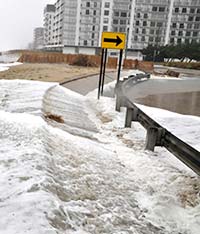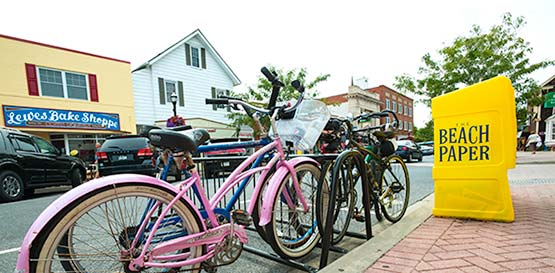



By teresa messmore College of Earth, Ocean, and Environment

When a storm hits, Delaware’s coastal communities know which areas are likely to flood. But what will happen in coming decades when predicted sea levels are higher? How will the flood zones expand? Can stormwater systems handle increased demands? Will homes and businesses be safe?
The Delaware Sea Grant College Program is helping residents and municipalities prepare beyond existing hazard mitigation efforts, which are typically based on current and historic risks.
“It’s important for communities to plan with a longer-term view of hazards that includes future impacts associated with climate change,” says Wendy Carey, coastal processes specialist. “We encourage people to plan for future flood risk, whether it’s because of the next big storm or sea level rise.”
Delaware Sea Grant partnered with the city of Lewes to expand upon plans designed to minimize damage from hurricanes, nor’easters and tropical storms. They assessed vulnerabilities related to natural hazards and climate change, such as temperature increases, rising sea levels and more intense storms. Workshops were convened to receive input from the public, prioritize issues of concern and develop action strategies. The City of Lewes Hazard Mitigation and Climate Adaptation Action Plan was unanimously adopted by the Lewes City Council in 2011, one of the first such documents in the country.
Lewes’ Mitigation Planning Team is working to implement identified strategies as funds and staff time allow, starting with public education on hazards, emergency preparedness, groundwater safety and flood and wind insurance. Since FEMA flood zones are based on historic risk without sea level rise factored in, Carey shares information on best practices, such as why property owners should consider building beyond minimum elevation requirements. Raising first floor elevations by 12 to 18 inches, for example, provides better protection from flood damage and may reduce insurance premiums.
In Delaware City, Sea Grant is working with the local community to address natural hazards and climate change in relation to infrastructural upgrades, land-use plans and building standards, ecosystem protection, and disaster prevention and preparedness. Stormwater system improvement is a priority, with flooding from the Delaware River potentially exacerbating drainage problems as sea level rises and storms become more severe.
“This is a small community with issues that a lot of larger cities located at the coast are also faced with,” Carey says, adding that floods have historically impacted Delaware City’s business district and residential areas.
A community task force, including elected officials, business leaders and representatives of local historic preservation and planning commissions, will use interactive whiteboard technology and geographic information system (GIS) maps to pinpoint trouble areas as a group. Collaborating with the Partnership for the Delaware Estuary and The Resiliency Place, Delaware Sea Grant is working with Delaware City to enhance the hazard mitigation planning process and create an action plan that can accommodate future changing conditions.
The New Jersey Sea Grant Consortium and Pennsylvania Sea Grant also will work with the project partners to extend climate adaptation outreach efforts to local governments regionally, sharing lessons learned from the process and explaining why it’s smart to build beyond current code requirements.
“What we’re hoping to do is develop a toolkit that will make it easy for other communities to take the same steps and develop the same materials to work themselves through the process,” Carey says.
